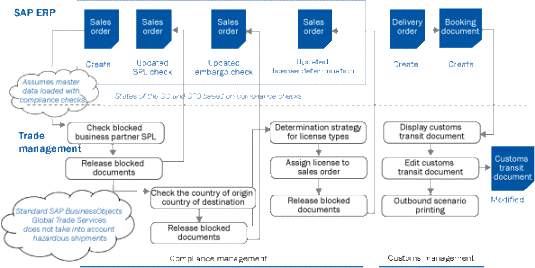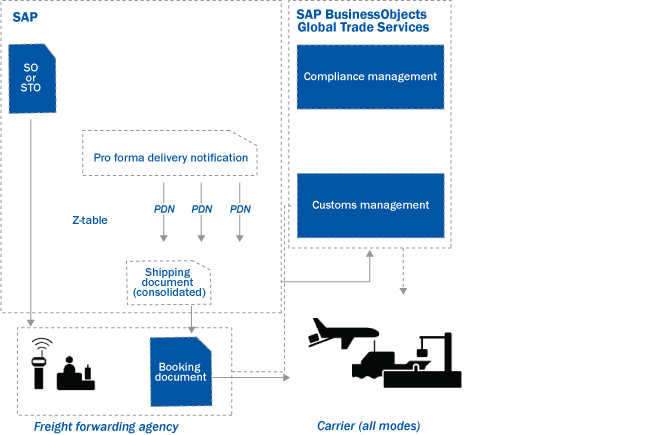SAPexperrts/GRC
When considering standard and non-standard order-to-cash processes, you can employ key workarounds to preserve standard SAP documents as the system of record. Understand the document flow of an order-to-cash process within a global trade operation, as well as the effects on plant operations. Then step through four example adjustments you can make to your order-to-cash process that keep you compliant with global trade policies and regulations.
Key Concept
SAP BusinessObjects Global Trade Services and other third parties require key order-to-cash process documents, including sales orders, delivery orders, and booking documents. SAP BusinessObjects Global Trade Services divides the documents between compliance management and customs management as part of its framework.
Developing a sound global trade and compliance strategy is essential in today’s marketplace of increased trade embargoes and unique product export licensing. SAP project teams may be challenged with incorporating the needs to implement SAP BusinessObjects Global Trade Services, focused in the areas of compliance and customs management, while maintaining the integrity of their order-to-cash sales order, shipment, and delivery documents. If these order-to-cash documents are not carefully managed, the global trade processes break down, creating delays and approval issues.
Imagine the case of a chemical-based product, which requires mixing, packaging, and shipping in a fixed window. What happens to the standard order-to-cash process when a product has these additional internal requirements? I’ll show you how to consider a number of both technical options and operating model alternatives to remove system constraints while still providing a compliant global trade solution. First, let’s look into the document flow of the order-to-cash process with global trade compliance in mind.
Note
William’s SAP PRESS book Understanding SAP BusinessObjects Enterprise Performance Management, which is now available, covers corporate sustainability, global trade, and other topics as they relate to strategy and enterprise performance management. For more information, visit www.sap-press.com.
Understanding Order-to-Cash Document Flow in Global Trade Compliance
SAP BusinessObjects Global Trade Services contains two primary areas: compliance management and customs management. Compliance management considers the needs of the company to fulfill orders that are permissible with trade restrictions (such as sanctioned party lists [SPLs]), and required export licenses for placing the product on a ship, plane, or truck to release any blocked documents such as a sales order. Customs management considers the customs documents required at the point of shipment, generally considered in the automated export system (AES) for each country.
SAP BusinessObjects Global Trade Services relies on key order-to-cash documents available in SAP ERP. These key documents and the compliance management and customs management processes are illustrated in Figure 1.

Figure 1
Key documents in SAP ERP order-to-cash processes for compliance management and customs management
In SAP ERP sales and distribution (SD), the sales order (or in the case of intra-company movement, the stock transfer order), is the main document that triggers the compliance management actions. After the sales order is created based on a purchase or transfer request, the ordering party is screened against the available SPL for the release of blocked documents so the order can be fulfilled.
Next the country of origin and country of destination are screened against country embargoes and any specific license requirements needed for export. After you verify that there are no order blocks, the sales order generally then commits the process to delivery, creating a delivery order. Deliveries invoke the transport carriers to create shipping documents, which then culminate with the booking documents needed to create final customs documents. These final customs management steps ensure the AES receives all required information, including container sizing and routing.
Accommodating Plant Operations and Product Structures
For product manufacturers, particularly those in the chemicals and process manufacturing segments, product structures and plant operation procedures can create conflicts with compliance and customs management processes.
First, a product made of certain substances can require specific packaging due to chemical composition. In essence, the later the plant mixes and puts the product into its packaging, the better, due to the cost of storing ingredients in inventory. Second, a high volume of stock transport order transactions can exist, moving substances in either final form or in an original pre-mixture status between various plants. Plant managers have a tendency to sit on stock transport orders for as long as possible with the hope that a sales order would come through the door and these internal transfers could be swapped for paid orders. This can create inventory visibility issues on the part of the requesting plant. Or a company might just resist changing its process because employees are used to the processes they have in place.
These approaches cause the following document processing effects. The delivery order triggers the shipping document. With a limited amount of time to fill orders, there can be no guarantee that all compliance management and customs management activities are performed. In addition, freight forwarding agencies that book the containers for export can create other process delays. In this case, some freight forwarding organizations rely on manual processes and proprietary systems communicating over several days’ delay via electronic data interchange (EDI) protocols, creating further constraints.
These effects may create unmanageable operational and system constraints to a trade compliance program, as shown in Figure 2.

Figure 2
Example system constraints when combining order-to-cash and global trade processes
Developing Compliance Alternatives
When developing alternatives within your order-to-cash process, it is best to consider those alternatives that are both feasible and viable. Feasible alternatives are those that you can create and deploy to solve a particular problem, mitigate a particular risk, or resolve a particular issue in a program. Most organizations stop short of considering whether that alternative is also viable. A viable alternative is feasible within the cost and schedule envelope available to the organization. In the case of the trade compliance program, there is a short window to identify both feasible and viable alternatives, of which the cost and schedule options are few. Let’s look at four potential alternatives:
- Change the operating model of the export process: One alternative is to consider changing the operating model of the organization’s export process to remove external parties (such as freight forwarding agencies) and move that work in house. Particularly if the organization is seeking ways to create new work processes in house and reduce external spend, adding customer service roles to this function can prove to be a net-positive cash flow and sound employee-relations move. These roles can either be created at customer service centers or in each of the plant sites depending on the organization structure of the company.
- Modify plant processes for improved inventory visibility: There are a number of inventory visibility approaches in which you can modify the plant processes so that inventory is not held in the fulfillment of sales order and stock transport order transactions. In these cases, the organization removes any hard allocation for the inventory. Customer service then only creates sales orders based on the requirements and the inventory is confirmed at the plant site based on the customer-requested date.
- Implement the customs management function in your global trade solution: The implementation of the customs management function itself can allow pre-population of the shipping and delivery information into the customs document and AES filing. By using the standard order-to-cash document flow, basic information such as shipment information, product content, licensure, destination routing, and freight schedule can be pre-populated into the customs documents as part of the final transport to the port of entry (e.g., air, land, or sea). In this case, there needs to be an interface to update all the information directly from your SAP system to AES. This can update all the delivery information directly to the customs systems for electronic AES filing.
- Use a pre-booking process that enables the parallel tracking of delivery information once the sales order or stock transport order was created. In this process you can interface with third-party carriers to update the booking process on sales orders or stock transport orders. This can be one of the most viable alternatives on the table and can be controlled within the scope of a typical trade compliance program as well. Implementation costs within a reasonable schedule window (e.g., an additional 5% to 10% of a project budget and schedule) can prove to be marginal relative to the risk exposure and total solution cost of a trade compliance program.
Through the use of a z-table, you can use a pro forma delivery notification (PDN) to capture initial state sales order information along with the freight forward delivery information. You can create this within 24 to 48 hours of the creation of the initial sales order. As the z-table exists outside of the formal document structure of the order-to-cash process, it does not affect the sales order, delivery order, or shipping order states as they progress through the compliance management process. In addition, once the final delivery order information is known, you can use the PDN to consolidate shipping order information, providing greater efficiency in export container use. Figure 3 provides an overview of this conceptual process flow.

Figure 3
Conceptual process diagram for pre-booking and delivery consolidation
While the ideas and practices described in this article may fit for some SAP project teams’ order-to-cash processes with global trade solutions, each organization has its own unique document structure. Using some creative thinking, you can adapt these ideas around the organization operating model, business process, and technical architecture you have in place.

William Newman
William Newman, MBA, CMC is managing principal of Newport Consulting Group, LLC, an SAP partner focused on EPM and GRC solutions. He has over 25 years of experience in the development and management of strategy, process, and technology solutions spanning Fortune 1000, public-sector, midsized and not-for-profit organizations. He is a Certified Management Consultant (CMC) since 1995, qualified trainer by the American Society of Quality (ASQ) since 2000, and a trained Social Fingerprint consultant in social accountability since 2012. William is a recognized ASUG BusinessObjects influencer and a member of SAP’s Influencer Relations program. He holds a BS degree in aerospace engineering from the Henry Samueli School of Engineering and Applied Science at UCLA and an MBA in management and international business from the Conrad L. Hilton School of Management at Loyola Marymount University. He is a member of the adjunct faculty at both Northwood University and the University of Oregon with a focus on management studies and sustainability, respectively.
If you have comments about this article or BI Expert, or would like to submit an article idea, please contact the editor.
You may contact the author at wnewman@newportconsgroup.com.
If you have comments about this article or publication, or would like to submit an article idea, please contact the editor.









